
|   |

|   |
Gracefully expressive icons give a glimpse of the divine - Jyothi Raghuram e-mail: jyothi.r.ram@gmail.com Photos: BV Madhukar May 15, 2022 Sometimes, rarely so, one cannot put into words the outing of an ace dancer, fame and seniority not being the deterrents. The experience created in the audience can be so sublime that it seems inane to write about it. And when one is speaking of five such icons, there's certainly a crisis in one's vocabulary! Accompanied by a fine set of musicians, the dancers gave a transcendental abhinaya recital that made the audience teary-eyed, ecstatic, deeply emotional. Sparkling Padmini Ravi, elegant Deepak Mazumdar, lively Veena Murthy, spirited Prathibha Prahlad, and radiant Chitra Visweswaran proved without exception that youth and agility is no match for a lifetime of sincere quest in dance. Got up by famed Bharatanatyam dancer Satyanarayana Raju, Samskruthi Rasaabhinaya Festival 2022, sans percussion, at the compact Vyoma Art Space in Bengaluru last weekend, was akin to intimate theatre, where the line between the dancer and audience defied physical space, to become a joyous celebration of life through art. The artistry of abhinaya assumed unimaginable vistas, the interpretative depth, visual and moving experience echoing among the viewers as intense emotions that captured a palpable divinity. It was not just maturity that was the forte of the dancers; it was their seeking of the vast super-conscious through the stimulus and understanding of dance; the dancers became the dance, creating some of the most memorable, elevating moments in dance that one has experienced.  Padmini Ravi Padmini Ravi, a dancer full of curiosity, continuously exploring and known for bringing new dimensions to dance, opened the festival, presenting three paasurams (Tamizh hymns in praise of Vishnu), each divergent in approach, but eventually merging with the ultimate reality. Nammalvar's Udayavan Yavanavan (Ragamalika), referenced Niraakara Brahman and Saguna Brahman, where the individual consciousness merges with the ultimate wholeness, surrender being of essence to move from the unreal to the real. The manodharma of Padmini, born of her individual inner journey, translated the abstract concept into a feeling of oneness with all creation. She next chose a narrative mode, Adanda Vennai (Ragamalika), with Yashoda waiting to give a soiled little Krishna an oil bath. With the ablutions over after much cajoling, a deeply satisfied Yashoda immersed in her child, to the strains of Maanikyame, Yenn Maniye, had an endearing as well as spiritual appeal. This paasuram was that of Perialvar or Vishnuchitta, the father of Andal. Anru Ulagam (Shuddhasaarang), a verse from Nachiyar Thirumozhi (Andal is also known as Nachiyar) was an appeal by her to her koel (cuckoo) to bring Krishna to her, at the literal level. From an entry with Om Namo Narayanaya to the culminating refrain of Hari Narayana, it was an inspiring, uplifting, mystical experience. 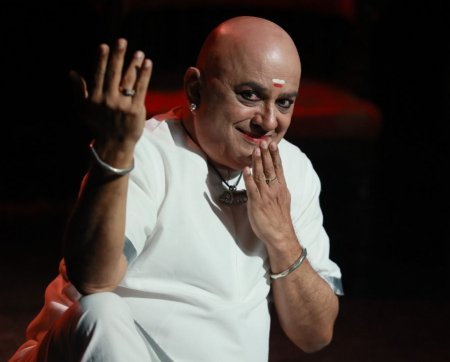 Deepak Mazumdar Deepak Mazumdar, who can at once be a coy damsel as much as a robust hero without being either effeminate or macho, has been an inspiration for male dancers for decades. He does not play roles on stage; he transforms into the character, crosses gender barriers with ease, and loses himself in the feel of the moment. His poignant emoting invariably leaves the audience spellbound. Rasaabhinaya once again witnessed Deepak's evocative abhinaya, the pieces he chose, in reality, barely using sahitya, yet imaginatively developing on the essence of it; Nandanar's Varugalaamo (Maanji), Krishna Nee Begane (Yaman Kalyani), Kuru Yadunandana (Tilang), and a verse from Valmiki Ramayana in Hamsanada, encompassed pathos, devotion, love in its many manifestations from maternal to erotic to sacred, sensuousness and sringara in all its glory, separation, isolation-- all culminating in the longing and becoming one with divinity. Subtlety was the core; flavorful was the leisurely handling. Deepak's connect with his audience was a metaphor for godliness. 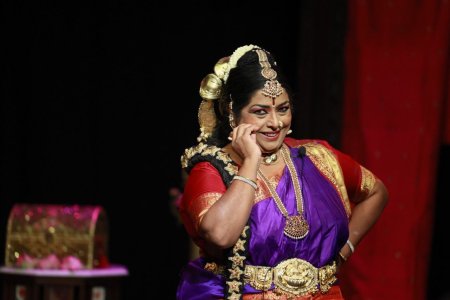 Veena Murthy Vijay Coquettish, arrogant, yet feminine, the bejeweled Satyabhama never fails to entertain. Veena Murthy Vijay's portrayal, going beyond the stereotype, was full of symbolism that filtered down to the viewer with an in-depth meaning. The Bhama Kalaapam, expectedly beginning in Bhairavi and moving on to Ragamalika, was laced with humour, as in the dialogues between Satyabhama and the Sutradhaara. A lively Veena, while reveling as the most beautiful and accomplished of Krishna's consorts, yearns for him, culminating in the metaphysical aspect of the jeevatma uniting with the paramatma. As a seasoned dancer, Veena delightfully sketched the superficial, distinctive traits of Satyabhama, eventually sublimating all of it into a higher consciousness. The glittering ornaments of Satyabhama encapsulate this philosophy, Veena said in a brief introduction. The long, bedecked braid, synonymous with the personality of Satyabhama, holds within it an entire understanding of the cosmos. The braid, sporting sparkling stars, represents the 27 nakshatras, the three kuchhus represent the sky, earth and nether world; a further division of three sets of nine kuchhus standing for the nine planets, as also the three gunas of satva, tamo and rajas, surya and chandra, with adishesha literally the crowning glory representing Mahavishnu--Veena dwelt on the influence of the celestial bodies on one's life. An informative talk indeed, but it didn't take away from her subsequent depiction of the haughty, attractive Satyabhama! One did not miss the toe-tapping rhythmic aspect of the form, so bubbly and bright was Veena. Her quick witted dialogues and repartees had a charming spontaneity that also drew the audience to her. A dancer whose sprightliness and enthusiasm are very much intact! Surya Rao as the Sutradhaara, was a perfect match to Veena. 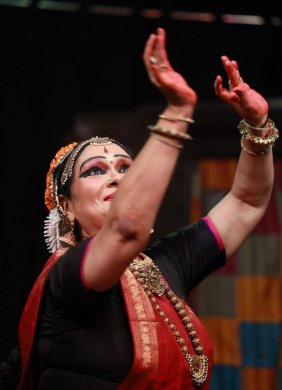 Prathibha Prahlad What a unique concept Prathibha Prahlad had thought out for Rasaabhinaya! And how imaginatively she presented it. Classical items were chosen with an exact match in the Hindi films songs of Lata Mangeshkar, adapting the classical to project popular culture. Conceived as a tribute to Lata, Sringara in its varied expressions, was of essence to Prathibha's recital. The ashtapadi Sakhi he (Maanjh Kamach) was juxtaposed with Jaane Kya Baat, Radhika Krishna (Vaasanthi) was knit with Yeh Dil Tum Bin, Natha Hare (Desh) with Neela Aasmaan, followed by the padam, Yaarukaagilum Bhayama (Begada) with Pyar kiya tho darna kya, to arrive at a seamless amalgamation, artistically and emotionally. No doubt the appeal of the well-chosen, apt melodies of Lata was a highlight of Prathibha's outing; to use the classical idiom, and relate a number from its mould to a film song with similar sentiments, requires a sharp intellect and exceptional choreographic skills; therein lay Prathibha's ingenuity. Her presentation was a forward thinking, challenging exploration which gave a new turn to the body of Bharatanatyam. A mind-blowing recital, both in conceptualisation and execution. 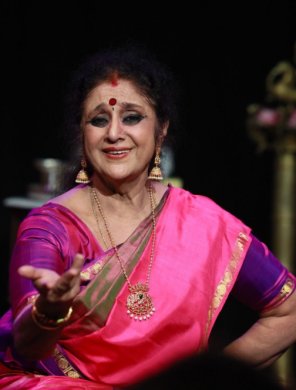 Chitra Visweswaran Invoking Shiva, Shakti and Vishnu, stunning Chitra Visweswaran was a picture of serenity, even while representing the entirety of creation through their attributes, Shambho Mahadeva and Maata Kaalika among others built up to a crescendo to the strains of Sarvam Vishnumayam, the episode of Bali Chakravarthi reaching a zenith in its interpretative layers. Underlying all this was the philosophy of Tat Tvam Asi. Chitra's soft movements complemented the clarity of her communication, lost as she was in the contemplation of the divine. Gracious and myriad were her expressions; comely, composed, and exquisite, she was the personification of a dance diva. Rasaabhinaya certainly wouldn't have touched hearts without the soulful rendition of the superb musicians. Young vocalist Raghuram R, who has dabbled in film music with success, uplifted Padmini's portrayal, even while freely combining the classical with the dramatic, which defied genres. The lyrical quality of Raghunandan's flute, with its warm depth, created magic, especially considering that Krishna was the recurring theme on both days of the festival. Singer Balasubramanya Sharma, whose long innings as a vocalist for dance vouches for his popularity, matched the many moods of Deepak, as did Srikanth for Chitra, while the musical articulation of Deepthi Srinath for Veena Murthy had a zing to it. The range and clarity of well-known vocalist Pustakam Ramaa, and the vocal of Supriya, who sang Lata's melodies, were as much the high points of the festival. The skills of Sunaad Aroor (konnakol), Vishal Ramprasad (keyboard), and DV Prasanna Kumar (cymbals) made the musical segment wholesome. Pranitha was the tambura artiste. Lighting by MG Naveen was effective. The festival was organised by Samskruthi The Temple of Art and Abhai. Stage props put up by Satyanarayana Raju had a royal feel, complete with fragrant jasmines and gossamer veils, which the dancers used with telling effect. A soul stirring dance experience, if ever there was one. Please Satya, may we have some more?! 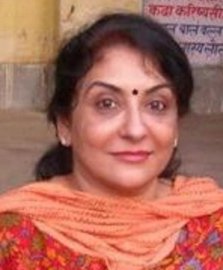 Jyothi Raghuram is a senior journalist and art critic based in Bangalore. |